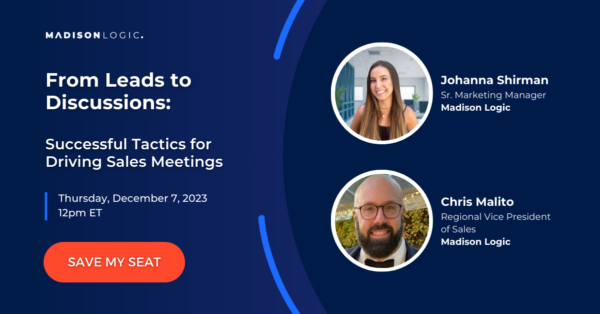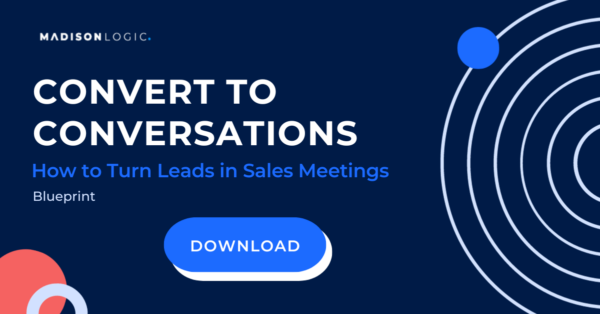
Why Leads Get Stuck in the Pipeline (and How to Get Them Unstuck)

Lead generation is a critical part of growing a business, but what happens when leads become stuck in the pipeline? It’s an all-too-common issue for marketers that can lead to missed opportunities and lost revenue.
When you focus on why leads come to you in the first place, you’ll not only have more success staying top of mind as they evaluate solutions and capitalizing on their readiness to buy—you’ll give them the attention and personalization they require to empower them to schedule a meeting with a sales representative, which accelerates the buying journey at scale and has a greater impact on overall company performance.
In this article, we’ll look at why leads get stuck in the pipeline and provide best practices for getting them unstuck. By exploring topics such as aligning your strategy to your data, creating personalized content and messaging, using a multi-channel approach, cross-collaborating with sales, and measuring and optimizing campaigns, you’ll be able to ensure your leads don’t get stuck in the pipeline.
Common Causes of Stuck Leads
When a lead is stuck in the funnel, it means that they are not progressing toward an interaction with sales. It’s important to understand why this happens to get them unstuck and prevent it from happening with other leads.
One of the most common reasons leads may be hesitant to move forward is because they are not aware they have a problem in the first place. This could be due to a lack of education or awareness of their current needs or challenges. Without that sense of urgency to solve a business concern they haven’t identified, they may not see the need to take any action—hence, they lose momentum and get stuck in the pipeline.
Another common cause is that leads may not have enough information about your brand or solution to trust it. If they don’t know enough about you, how will they know if you can provide them with what they need? At the same time, too much information from you and your competitors can also be overwhelming for potential customers and lead them to become overwhelmed and stuck before making a decision.
Finally, a lead you’re trying to move through the pipeline may no longer be part of the buying committee. This could be due to changes in personnel at their organization or other factors that mean that the individual who initially expressed interest is no longer involved in the decision-making process. It’s important to reach multiple members of the buying committee to be considered on any solution shortlists.
The Five Steps to Keep Leads Moving Through Your Pipeline
Generating enough interest to unstick leads and drive sales engagement comes down to how well you demonstrate that you understand the buyer’s concerns, create a sense of urgency around solving their concerns, separate your product or service from competitors, and understand their buying behaviors and your sales cycle.
The only way to achieve this is through a data-driven, multi-channel account-based marketing strategy that moves your leads from consideration to conversion. Here’s how to set your strategy up for success:
Step 1: Align Your Strategy to Your Data
The key to good campaigns is good data. But the key to moving quality leads through your sales funnel lies in how you interpret your data. Well-maintained data flows from your ability to gather the necessary insights into your leads, which allows you to be more strategic when developing your lead-to-appointment strategy.
The key here is the use of multiple data sources to identify trends and patterns within your lead pool and create strategies that take advantage of these insights. For example, if you know that certain leads are more likely to convert when approached through a certain channel or with a certain message, focus on those channels and messages for those leads. Your lead’s demographics (job title, age, etc.), technographic data (software applications, cloud service, etc.), and firmographic data (industry type, company size, annual revenue, etc.) play a major role in how you want to segment your leads for a nurture strategy. Segmenting your lists around what will entice leads to meet with your sales team (such as relevancy, timeliness, and personalization) demonstrates that you understand their motivations and business concerns.
Step 2: Create Content That Speaks to Them
More buyers are conducting their own research, resulting in fewer interactions with sales. With Gartner data indicating that sales reps have roughly 5% of a customer’s time during their B2B buying journey, it’s up to the marketing team to provide a sense of urgency and compelling case for their solution to move them through the buyer’s journey. Your content and messaging must not only show your expertise in the industry, but it also needs to create a sense of urgency toward seeing the product or service in action, which buyers can quickly witness with a demo request or conversation.
The key to personalized buyer experiences is by appealing to their emotions. While your intent data reveals your audience’s behaviors, a lead is still likely downloading plenty of assets from your competitors—potentially at the same time and especially if they’re in the discovery and research phase of their buyer’s journey.
Your content needs to stand out by appealing to your leads’ emotions. Think about the last time you encountered content or messaging that spoke directly to your thoughts and concerns. People remember how they feel as they read more than they do the details of what they read. If you create an emotional bond with your lead, you continue to set a strong foundation to establish trust between your company and the lead, so they’ll be more inclined to hop on the phone with your sales team.
Step 3: Surround Accounts Through a Multi-Channel Approach
Reaching prospects with a unified strategy across the multiple channels they use the most is an effective way of ensuring they don’t get lost in the funnel. If you’re only using a single channel to nurture these leads, you end up missing out on crucial opportunities to strike.
Think about how each channel can help you continue your lead-to-sales campaign differently and integrate them thoughtfully. You can mix and match your channels based on the hurdles you’re looking to clear in securing a meeting. For example, use content syndication to showcase brand expertise and highlight competitive advantages while leveraging LinkedIn advertising to increase exposure and encourage deeper interactions.
Retargeting campaigns are a great way to maximize exposure when you’re continuing to nurture your leads toward booking a sales meeting. Think about it: How many times have you downloaded an eBook or registered for a webinar, then completely forgotten about it? Leaning heavily into retargeting, particularly through LinkedIn and display ads, plays a pivotal role in increasing exposure and ensuring your leads remember who you are and why they came to you in the first place. LinkedIn retargeting allows you to remain visible to decision-makers in a business context through a trusted business platform. Display advertising, with its broad reach across the web, reinforces visibility and serves as a reminder to your leads that your offering provides the value that they’re looking for.
See it in action. Learn how Madison Logic helps Vonage execute a full-funnel, multi-channel ABM strategy with ABM Content Syndication, ABM Display Advertising, and ABM Social Advertising with LinkedIn.
Step 4: Cross-Collaborate with Sales
Close collaboration between sales and marketing teams ensures that leads are properly nurtured throughout the entire engagement. Marketing teams that focus solely on marketing strategy and the success of gaining marketing-qualified leads often miss the mark on meeting their goals.
Research from The Harvard Business Review found that 90% of sales and marketing professionals report misalignment in terms of their organizations’ strategy, process, culture, and content, and nearly all respondents of the same survey believe this harms their business and customers. If your strategy remains “marketing does this and sales does that,” it’ll lead to poor coordination and sluggish sales velocity—which impacts the company’s bottom line. If the goal is to move leads toward meeting with the sales team, you need to align your efforts with your sales team.
Both marketing and sales need to keep in mind that inbound leads are most likely familiar with your product. If the lead is ready for a sales meeting, they understand the brand. So, when a representative reaches out, they need to introduce themselves—not the solution from a general, informational view. Here’s where the marketing team can offer outreach templates that match the buyer persona and outline a specific problem for the sales team to personalize. These customizable templates easily pave the way to a positive experience versus one that feels disjointed between the lead’s stage within the funnel and overall engagement.
Interested in learning more? Watch our leads to discussions virtual event on demand:
Step 5: Measure and Optimize Your Campaigns Toward Success
This is less of a last step and more of a continuous measurement and evaluation process to figure out whether your campaigns are successful, and then optimizing your strategy with those findings. Keep your eye on the market and continue to collaborate with the sales team, as market conditions impact the customer cycle, and your pipeline and revenue goals may adjust from quarter to quarter.
Company size and growth stage impacts where you align with your overall industry marketing benchmarks. Still, understanding foundational marketing and sales metrics, like customer acquisition cost, conversion rate, and deal velocity, and how each channel impacts them will show how successful your channels are in terms of engagement, and where you can maximize results. Breaking your marketing and sales metrics down into their leading and lagging indicators allows you a deeper layer toward understanding how your content and messaging performs across campaigns. Leading indicators contribute to your goals but aren’t guaranteed and can fluctuate from campaign to campaign, month over month. Lagging indicators take longer to measure, and need ample time before optimizations should be made. You’ll want to gather historical data for both, but lagging indicators will be more quantifiable after going through your sales cycle two or three times.

Level-Up Your ABM Strategy to Get Leads Unstuck
With the number of in-market accounts dwindling, receiving an inbound lead is not necessarily a signal that an account is ready to make a purchase. There are a variety of factors that may be preventing your prospects from speaking to your sales team, which further delays calculating your conversion rates and ultimately impacts your campaigns’ ROI. Implementing these five steps into your campaign strategy and setup helps ensure that your leads don’t get stuck in the pipeline and instead advance into sales-ready prospects.
Wish you had a step-by-step guide to help you understand how to advance your leads into sales-ready prospects? Download the Convert to Conversations: How to Turn Leads into Sales Meetings Blueprint for actionable tips that not only help you develop a strong, repeatable approach to your campaign strategies but also motivate your leads to schedule and take those worthwhile sales meetings. Use it as a guide to evaluate your current workflow or identify areas where you can level up.




